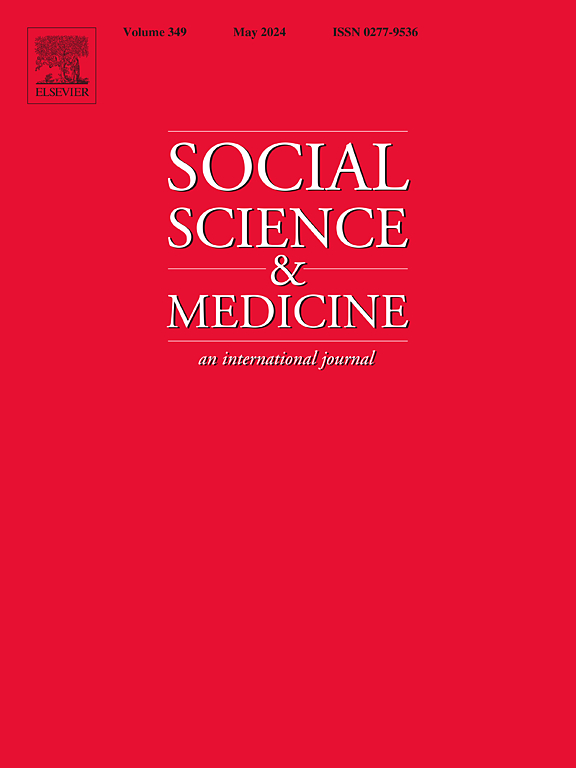青少年至成年期体重指数的发展:基因型与家庭社会经济地位的相互作用研究。
IF 5
2区 医学
Q1 PUBLIC, ENVIRONMENTAL & OCCUPATIONAL HEALTH
引用次数: 0
摘要
青少年和成年期的体重可能是由个体的遗传特征和他们成长的社会环境(如家庭社会经济地位)之间的相互作用造成的。然而,关于高体质指数(BMI)的遗传倾向与家庭经济地位之间的相互作用的证据仍然没有定论。这项研究调查了高社会经济地位与低社会经济地位家庭的个体与BMI的遗传关联是否不同,以及这些关联是否在整个生命过程中有所不同。利用国家青少年到成人健康纵向研究(Add Health)的数据,研究了青春期(≃16)、成年早期(≃22)、成年(≃28)和成年后期(≃37)四个生命阶段BMI多基因指数(BMI PGI)与BMI的关系。结果表明,相对于高ses家庭,BMI PGI对低ses家庭个体的BMI具有更强的预测作用。这种相互作用在生命过程中减弱,但在高BMI水平的个体中持续存在。这些发现表明,高ses家庭可以缓冲超重和肥胖的遗传倾向,而低ses环境可能会加剧这些倾向,增加BMI升高的风险。研究结果强调了家庭社会经济背景在形成BMI结果中的重要性,并强调了环境干预(如促进健康饮食和体育活动)如何有助于减少健康方面的社会不平等。本文章由计算机程序翻译,如有差异,请以英文原文为准。
The development of body mass index from adolescence to adulthood: A genotype-family socioeconomic status interaction study
Body weight in adolescence and adulthood may result from the interplay between individuals’ genetic characteristics and the social context in which they grow up, such as family socioeconomic status (SES). However, evidence on the interaction between genetic propensity for high body mass index (BMI) and family SES remains inconclusive. This study investigates whether genetic associations with BMI differ among individuals from high-SES versus low-SES families and whether these associations vary across the life course. Using data from the National Longitudinal Study of Adolescent to Adult Health (Add Health), I assess the association between a polygenic index for BMI (BMI PGI) and BMI at four life stages: adolescence (≃ 16), early adulthood (≃ 22), adulthood (≃ 28), and later adulthood (≃ 37). Results show that the BMI PGI is more predictive of BMI among individuals from low-SES families than from high-SES families. The interaction weakens over the life course but persists among individuals with high BMI levels. These findings suggest that high-SES families may buffer genetic propensities for overweight and obesity, whereas low-SES environments may exacerbate them, increasing the risk of elevated BMI. The results underscore the importance of family socioeconomic background in shaping BMI outcomes and highlight how environmental interventions, such as promoting healthy eating and physical activity, may help reduce social inequalities in health.
求助全文
通过发布文献求助,成功后即可免费获取论文全文。
去求助
来源期刊

Social Science & Medicine
PUBLIC, ENVIRONMENTAL & OCCUPATIONAL HEALTH-
CiteScore
9.10
自引率
5.60%
发文量
762
审稿时长
38 days
期刊介绍:
Social Science & Medicine provides an international and interdisciplinary forum for the dissemination of social science research on health. We publish original research articles (both empirical and theoretical), reviews, position papers and commentaries on health issues, to inform current research, policy and practice in all areas of common interest to social scientists, health practitioners, and policy makers. The journal publishes material relevant to any aspect of health from a wide range of social science disciplines (anthropology, economics, epidemiology, geography, policy, psychology, and sociology), and material relevant to the social sciences from any of the professions concerned with physical and mental health, health care, clinical practice, and health policy and organization. We encourage material which is of general interest to an international readership.
 求助内容:
求助内容: 应助结果提醒方式:
应助结果提醒方式:


